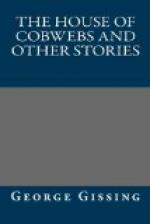there are indeed many to be discovered hidden away between these pages. And the beautiful verse has a fine parallel in the prose of one of Gissing’s later novels. ’Some girl, of delicate instinct, of purpose sweet and pure, wasting her unloved life in toil and want and indignity; some man, whose youth and courage strove against a mean environment, whose eyes grew haggard in the vain search for a companion promised in his dreams; they lived, these two, parted perchance only by the wall of neighbour houses, yet all huge London was between them, and their hands would never touch.’ The dream of fair women which occupies the mood of Piers Otway in the opening passage of the same novel, was evidently no remotely conceived fancy. Its realisation, in ideal love, represents the author’s Crown of Life. The wise man who said that Beautiful Woman[27] was a heaven to the eye, a hell to the soul, and a purgatory to the purse of man, could hardly find a more copious field of illustration than in the fiction of George Gissing.
[Footnote 27: With unconscious recollection, it may be, of Pope’s notable phrase in regard to Shakespeare, he speaks in his last novel of woman appearing at times as ‘a force of Nature rather than an individual being’ (Will Warburton, p. 275).]
Gissing was a sedulous artist; some of his books, it is true, are very hurried productions, finished in haste for the market with no great amount either of inspiration or artistic confidence about them. But little slovenly work will be found bearing his name, for he was a thoroughly trained writer; a suave and seductive workmanship had become a second nature to him, and there was always a flavour of scholarly, subacid and quasi-ironical modernity about his style. There is little doubt that his quality as a stylist was better adapted to the studies of modern London life, on its seamier side, which he had observed at first hand, than to stories of the conventional dramatic structure which he too often felt himself bound to adopt. In these his failure to grapple with a big objective, or to rise to some prosperous situation, is often painfully marked. A master of explanation and description rather than of animated narrative or sparkling dialogue, he lacked the wit and humour, the brilliance and energy of a consummate style which might have enabled him to compete with the great scenic masters in fiction, or with craftsmen such as Hardy or Stevenson, or with incomparable wits and conversationalists such as Meredith. It is true, again, that his London-street novels lack certain artistic elements of beauty (though here and there occur glints of rainy or sunset townscape in a half-tone, consummately handled and eminently impressive); and his intense sincerity cannot wholly atone for this loss. Where, however, a quiet refinement and delicacy of style is needed as in those sane and suggestive, atmospheric, critical or introspective studies, such as By the Ionian




